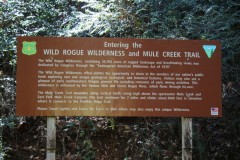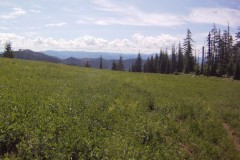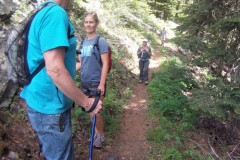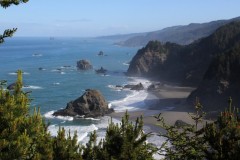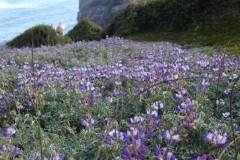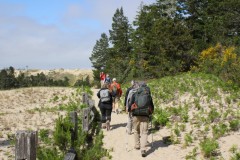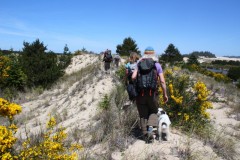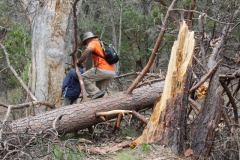Hike coordinator: Lane Harris
Narration by Lane Harris
One thing is certain when you visit Crater Lake, you are NOT alone! This also applies to the hiking trail which leads to the highest peak in the national park, Mount Scott. By the time our party of nine had reached the trailhead, there were already droves of hikers on the trail, both coming and going.
This late July hike began with a gradual climb among firs and pines, which kept us shaded for a good part of the hike. However, as we climbed higher, the trees got sparser and the trail got a bit steeper. Heavy-breathing hikers reached for their water bottles and dabbed sweat off their brows in the midday heat. As we gained altitude, the teasing, eye-pleasing views looking back towards Crater Lake gave us inspiration to keep going. We knew there had to be a spectacular view awaiting us at the top!
Many hikers were already heading back down. Others were quickly on their way up. In fact, some of us slower hikers were easily passed by some of these more enthusiastic hikers who were obviously eager to get to the top. Most appeared to be young, college-aged, and athletic that looked primed for a triathlon. Passing by us like we were standing still and reminding us of when WE were young. Sigh!
Anyway… The trail threw no less than five switchbacks at us as we drew near the top. Each one gave us a better view of the lake below. Eventually, we rounded a corner and the lookout which sits atop Mount Scott finally came into view. We were nearly level with it! An easy jaunt across a treeless ridgeline, which provided tremendous views to the north and south, led all those who made the trudge up this mountain to the base of the lookout.
As we dined on our early afternoon lunches, next to the multitude of other hikers, everyone soaked up the beauty of that which is Crater Lake. The quintessential pictures of Crater lake, typically taken from close to the rim, cannot compare to the panoramic landscape view that is attained from two miles away at 8,934 feet!
From Mount Scott, you get a more expansive overall picture than you see from the crater’s rim. Viewing the lake from this distance puts everything in this area into perspective. From this vantage point, you get the true sense of the massive explosion that took place over 7,700 years ago. All that remains now of Mount Mazama is a crater nearly 6 miles wide! You can only imagine the devastation that took place here.
Mount Scott, which lies to the east of Crater Lake and within the park’s boundaries, not only provided true birds eye views of Crater Lake itself, but many mountain peaks. Unfortunately, there was no long-range views to the west due to the Milepost 97 fire which had just started 3 days earlier. A stream of smoke could be seen, hovering the earth as it flowed southward. A sad reminder of the perils that we deal with during the summer months here in the great northwest.
After a group photo on the ridgeline, we pointed our hiking boots downhill to begin the easy stroll back down, this time without all the heavy breathing and sweat! By the way: No young people passed us on the way down. It’s hard to walk faster than the more “mature” people who need to use the bathroom, get home to take their meds, and get in bed before 9:00.
More pictures on Lane Harris’ Flickr page
Pictures below by Lane Harris




